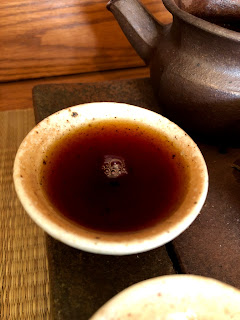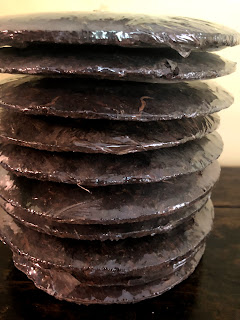After drawing on personal experiences, gathering as much
background information as possible from the seller, extensive internetresearch, and tasting this tea extensively I have come to the following
conclusions about whether this is actually a 1970s Guang Yun Gong Bing…
First, we know that this tea has to be produced in the 1990s
at the latest because that’s when the production of the series ended. This gives us an end point on the date of
this tea. The start date can be
determined by a visual identification- the use of the very unique “zhongcha
round ticket”. This type of neifi was
used exclusively on the Gong Yun Gong cakes, I believe. My research indicates that the use of the
round ticket started in the 1970s, but not in the early 1970s. This gives us a possible start point. From what I’ve read the 1970s cakes are more
“pre-cooked” than other years and as such have darker or blacker looking dry
leaves. These productions of Guang Yun
Gong tend to be more shu puerh like.
Both the dry leaves, wet leaves, are in line with this observation.
The information I obtained from the vendor seems to roughly
match this visual id as well as the tasting notes. Mr. Chan told me that this tea was stored in
non-traditional Hong Kong storage for at least 13 years then was very very dry
stored in Regina from 1993 onward. It was wrapped/sealed sometime in Regina. It is obvious that this tea had a least some
more humid storage as per the look of the dry leaves and wet leaves as well as
taste. There is also a distinct dry
storage taste as well as the preservation of high notes in the first handful of
infusions. In my experience the dry
storage taste like this would need at least 15-20 years of dry storage. If it was dry storage in the ultra-dry
prairies 30 years seems more reasonable.
That would place this tea in the mid 1980s. However, pictures and descriptions of the
1980s Gong Yun Gong that I have come across don’t support this at all. The leaves are more sheng puerh looking than
shu and the dry leaves look more like sheng as well in these 80s Guang Yun Gong. The tasting notes don’t fit with the 1980s
notes as good as the 1970s notes I’ve read.
The qi of the tea is an old qi feeling but I can’t distinguish an
approximate year or even a decade from qi alone. Who out there can?
A really interesting thing about the stack is that they all
look a bit different- some are redder and others more black colored, come look
like they might have got a touch mold that was removed in chunks but most are
clean. Some seem to be completely sealed
where others have tears, gaps, or holes in the plastic film. I think each one will have a slightly
different personality and taste to them.
It will be fun to explore this aspect of this stack.
So in the end, I have determined that this is quite possibly
a 1970s stack of Guang Yun Gong. I feel
like I need try to sample more extensively from reputable dealers or to send
some samples to those people who own some of these to be surer of my
conclusion. But, really, I don’t know if
I really want the price of samples used to validate these cakes to be more than
the actual price I paid for them! It
might be something I might explore for fun in the future though.
In the end these cakes aren’t super complex, special tasting
or even that amazing tasting. These teas
weren’t ever intended to be that. They
were produced even in the 1970s to be accessible and drinkable while containing
the full effect of cha qi. Does this
stack accomplish these things? Yes. Even in the early days of puerh
connoisseurship these cakes were used as everyday drinkers. Interestingly, this increased the rarity of
them because many were consumed rather than collected. Nowadays they have a nostalgic collectability
to them.
I kind of agree with classifying these as heicha rather than
puerh. They actually have a unique,
almost between heicha, shu and sheng taste to them. I don’t believe these contain any Yunnan mao
cha in them but my lack of experience with the Guang Yun Gong restricts me from
stating this confidently. Readers of this
blog might remember that I am a bit picky when it comes to what exactly is
classified as puerh (see here and here). Hahaha…
The qi is quite wonderful though and the aged taste is a
real treat. The iron pressing mixed with
the dry storage imparted this cake with some nice high notes still in
there. Something quite rare for a cake
this old. In fact, I have never ever
even heard of a cake that was dry stored in the West for 25 years, have
you? In this way these cakes are a real
treasure- the only known example of 25 years dry storage in the West-
apparently since 1993! That’s something
really interesting, I think. Maybe I
should try to get them certified as a Western puerh drinker’s cultural
intangible property… hahaha.
The main reason I find these so interesting is because it
gives us Westerners an idea of what basically unattended, long, overly dry
stored puerh can become and the outcome is not all that bad at all. If anything it supports the idea of sealed storage and iron machine compression. This doesn’t say much because obviously the
storage on these cakes could have been a lot better.
In the end, I am left feeling like these cakes are simply an
unpretentious, aged, everyday drinking tea which is just my style, really. But as a puerh drinker and not a collector, I am a bit torn what to do with these cakes that might be worth a fair bit and are one of a kind. What
would you do?
Also something should probably be said about the “herbal
medicine storage taste”. There is a
cultural difference between what tastes are valued in puerh amongst Westerners
vs Southeast Asia vs South China vs Mainland Chinese. In Asia, a strong Traditional Chinese
Medicine storage taste is not valued the same way it is in the West. For Westerners, this is a new taste with very
little memory attached to it. It
is exotic and interesting and can give the aged tea a different dimension and
depth to it. For those in Asia, they
often associate these tastes with very strong and bad tasting medicine that
their parents or grandparents forced them to take when they were small children. As a result a taste aversion to such things
can even occur. For Westerners it would
be like their puerh tasting like banana penicillin or cherry cough syrup. These Guang Yun Gong bings seem to carry this
herbal medicine taste, which I enjoy but which would command less attention in
Asia.
So there you go, the long and the short of it. I hope you enjoyed my detailed assessment of
these cakes over the last few posts. Thought
it would be both an interesting story and also an educational tool for those
trying to determine the age of an old puerh.
In some ways, I feel like I have only scraped the top of the ice burg
with these cakes… so is the mystery of puerh (… or hei
cha)
Peace














